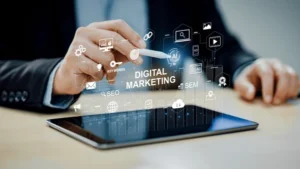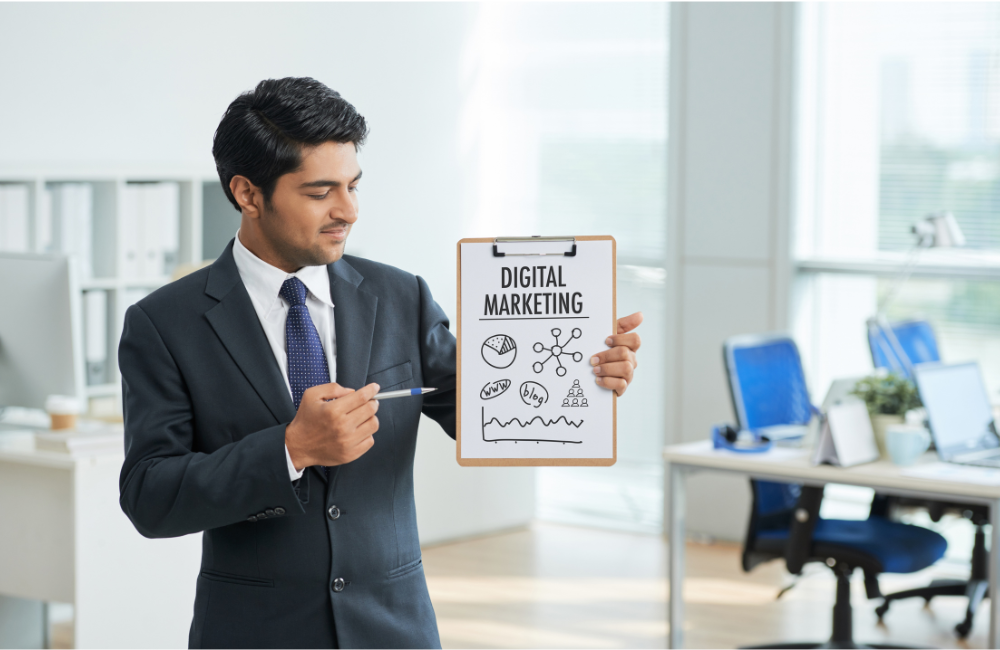In today’s fast-paced, digital-first world, businesses and brands must adapt or risk being left behind. Traditional marketing methods, while still relevant are gradually being overshadowed by the rapid growth of digital marketing. Whether you’re a small startup or a well-established company, understanding and harnessing the power of digital marketing is crucial for success.
In this comprehensive guide, we’ll explore digital marketing, why it matters, its various components, and how you can use it to drive business results.
What is Digital Marketing?
Digital marketing is a blanket term that refers to the use of the internet and digital technologies to promote products, services, or brands. Unlike traditional marketing channels (TV, radio, print) and digital marketing primarily focuses on online mediums to reach, engage, and convert customers.
From social media platforms to search engines, email campaigns, and mobile apps, digital marketing allows businesses to connect with their audience through multiple touchpoints. The beauty of digital marketing lies in its ability to use data to measure and optimize performance in real time.
Key Components of Digital Marketing
Now that we know digital marketing, let’s break down its core components. Digital marketing isn’t just one thing; it’s a combination of various techniques and strategies designed to work in harmony.
1. Search Engine Optimization (SEO)
SEO is the practice of optimizing your website to rank higher in search engine results like Google. The higher your website ranks, the more likely it is that people will find and visit your site. But SEO is not just about stuffing keywords; it involves a mix of strategies like:
On-page SEO: Optimizing your website’s content, structure, and meta tags.
Off-page SEO: Building backlinks and enhancing your website’s authority through external factors.
Technical SEO: Making your site more crawlable and user-friendly by focusing on aspects like site speed and mobile responsiveness.
When done right, SEO can generate organic (unpaid) traffic that continues to bring in leads long after the initial effort.
2. Pay-Per-Click Advertising (PPC)
PPC advertising involves placing paid ads on search engines or websites. With platforms like Google Ads, Facebook Ads, and LinkedIn Ads, businesses can target very specific demographics with laser precision.
You pay each time someone clicks on your ad, which is why it’s called “pay-per-click.” These ads appear at the top of search engine results or in social media feeds, giving your business immediate visibility.
PPC is a great strategy for businesses that need instant traffic, but it requires careful budgeting and ongoing optimization to ensure a positive return on investment (ROI).
3. Social Media Marketing (SMM)
Social media has become one of the most powerful tools in digital marketing. Platforms like Facebook, Instagram, Twitter, LinkedIn, and TikTok allow businesses to engage with their audience, promote content, and build relationships.
But social media marketing isn’t just about posting random updates; it’s about creating a social presence that resonates with your audience. This involves:
Content creation: Sharing relevant posts, articles, videos, or memes that appeal to your target audience.
Engagement: Responding to comments, and messages, and participating in conversations.
Paid social ads: Running targeted advertisements to boost brand awareness, drive traffic, or generate sales.
Effective social media marketing allows brands to build a community around their products, fostering customer loyalty and advocacy.
4. Content Marketing
In the age of information overload, content marketing is about offering value to your audience. Instead of pushing hard sales, content marketing focuses on educating, entertaining, or solving a problem for your audience.
This can take the form of blogs, videos, podcasts, infographics, and more. The goal is to create content that speaks to your audience’s needs and interests, positioning your brand as an authority in your industry.
Content marketing works hand-in-hand with SEO, as valuable content can help improve your search rankings while also building trust with your audience.
5. Email Marketing
Despite the rise of social media and other forms of communication, email marketing remains one of the most effective ways to directly reach your audience. Email marketing allows businesses to send personalized content, product updates, promotions, and newsletters to their subscribers.
By using segmentation, marketers can tailor emails based on customer behavior and preferences, ensuring each message is relevant to the recipient. Automation tools can even send targeted emails at the right moment in a customer’s journey, improving engagement and conversions.
6. Affiliate Marketing
Affiliate marketing is a performance-based strategy where businesses partner with individuals or other companies (affiliates) to promote their products or services. Affiliates earn a commission for every sale or lead they generate.
This method works well for businesses looking to expand their reach without committing to upfront advertising costs. You only pay affiliates for actual results, making it a cost-effective way to boost sales and brand visibility.
7. Influencer Marketing
Influencer marketing has exploded in recent years, as brands realize the power of leveraging influential figures to promote their products. Whether it’s a celebrity or a social media influencer with a large following, influencer marketing allows you to reach an engaged and loyal audience.
The key to success in influencer marketing is choosing the right influencer whose values align with your brand and whose audience fits your target demographic.
Why Internet Marketing Matters
So, why has digital marketing taken the world by storm? Here are some key reasons why it’s crucial for modern businesses:
1. Broader Reach
With digital marketing, your business is no longer limited by geographical boundaries. The internet has made it possible for you to connect with an audience anywhere in the world. Whether you’re a small local shop or an international brand, digital marketing levels the playing field.
2. Cost-Effectiveness
Compared to traditional marketing methods like TV, radio, or print ads, digital marketing is relatively low-cost. Platforms like Google Ads and Facebook allow you to set a budget and control how much you spend on each campaign. You can also optimize campaigns in real time, making it a highly flexible and cost-efficient way to advertise.
3. Real-Time Results and Analytics
One of the standout features of digital marketing is its ability to provide measurable results. Tools like Google Analytics give you instant access to key performance data, such as traffic, conversions, and engagement. This allows you to track the effectiveness of your campaigns and make data-driven decisions.
4. Targeted and Personal Marketing
Digital marketing allows you to target specific audiences based on their interests, behaviors, demographics, and even location. This means your marketing efforts are more likely to reach the right people, making it easier to convert prospects into customers.
The Future of Digital Marketing:
What to Expect: As technology evolves, so does digital marketing. Some emerging trends to watch out for include:
1. Artificial Intelligence (AI) and Automation
AI is transforming digital marketing by enabling smarter personalization and automating repetitive tasks. Chatbots, AI-driven recommendations, and predictive analytics are just a few examples of how AI is enhancing marketing strategies.
2. Voice Search and Smart Devices
With the rise of voice assistants like Alexa, Siri, and Google Assistant, voice search is changing the way people find information. Optimizing for voice search will become more important as these devices become even more integrated into daily life.
3. Video Marketing
Video is a powerful tool for storytelling, and it’s showing no signs of slowing down. From YouTube to TikTok, short-form and long-form videos are driving engagement like never before. Expect businesses to leverage video content even more as the format continues to dominate.
Conclusion
Digital marketing is no longer optional—it’s a necessity. The world is moving online, and your business must keep up to stay competitive. Whether you’re looking to increase brand awareness, drive traffic, or boost sales, digital marketing provides a variety of powerful tools to help you achieve your goals.
this blog is designed to be informative, attractive, and easy to read, covering the fundamental aspects of digital marketing and providing actionable insights for businesses to thrive in the digital age.
